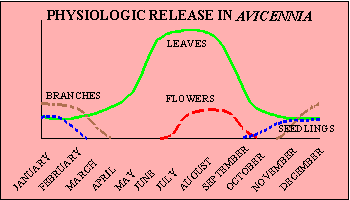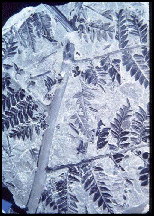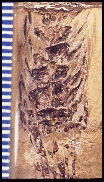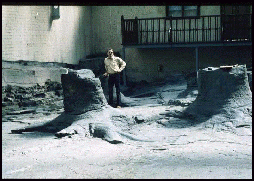
Life Strategies and Cycles influence contribution of plant parts in space and time.
The woody mangrove, Avicennia (black mangrove) is common along the world's coastal zones (mangroves colonize approximately 80% of the world's coastlines). Biomass production in mangrove swamps averages 615 gm/m2/yr, with the release of plant parts physiologically controlled (Lopez-Portillo and Excurra, 1985).

A single, mature deciduous tree (angiosperm) can abscise nearly 100,000 leaves in a single year (K. Johnson, pers. comm. 5/89). With a life expectancy of several centuries, the total number of leaves that could be contributed exceeds several hundred million. Once again, periodicity of plant part loss is governed by life strategy.
The way in which a plant is constructed (its histological structure) plays a significant role in preservability.
When Hurricane Diana swept through south Florida in the 1960's:
Physico-chemical attributes of different plant parts are responsible for the diverse rates of decomposition and what remains thereafter.

Labile and easily biodegradable biochemicals are consumed preferentially. Plants constructed of these are rarely preserved. The most resistant biopolymers (see above) and a variety of alteration products remain intact in the fossil record.
Fossilization of Cuticle is NOT a random occurrence, but based upon original biochemistry.
DIAGENESIS - Processes involving physical and chemical changes in sediment (and that which is incorporated in the sediment) after deposition that converts it to consolidated rock. This includes post-burial, compaction, cementation, and recrystallization (metamorphism).
Burial in and of itself does not prevent continued degradation or further alteration.
Compressions
 - The devolatilization
of the functional groups comprising the organic compounds results in the
concentration of the non-volatile chemicals. Cellulose components are reduced by hydrolysis with an increasing
lignin component. Geochemical alteration follows biological alteration. This concentration may result in the
coalification of the plant part (depending upon original histological composition).
- The devolatilization
of the functional groups comprising the organic compounds results in the
concentration of the non-volatile chemicals. Cellulose components are reduced by hydrolysis with an increasing
lignin component. Geochemical alteration follows biological alteration. This concentration may result in the
coalification of the plant part (depending upon original histological composition).
Impressions
 - Complete or nearly
complete degradation (often resistant waxy cuticles remain) of the plant part
within a clastic matrix may result in the preservation of it's outline (and prominent morphological
characteristics).
- Complete or nearly
complete degradation (often resistant waxy cuticles remain) of the plant part
within a clastic matrix may result in the preservation of it's outline (and prominent morphological
characteristics).
Adpression
- A term used by
Shute
and Cleal (1987) to describe a plant fossil specimen showing a mixture of
compression (plant parts compressed by sediment where some original or chemically altered plant tissue is still
preserved) and impression (an imprint of the fossil plant on sediment or rock surface) states.

An example of authigenically preserved plant fossils can be found at
MAZON CREEK.
Authigenic Cementation
- As
devolatilization proceeds, microgeochemical gradients that may be present in
fine-grained clastics (particularly reactive clays minerals and available cations in the pore waters) may cause
the precipitation of carbonate minerals (calcite, siderite, pistomesite) around the organic matter. The result is
the precipitation of a spherical to elliptical concretion around the nucleating organic material.
Permineralizations
 - Reactive
mineral-charged waters may permeate plant cells and react with cell walls.
Crystallization of a variety of minerals on the cell walls and within the cell lumens results in the
permineralization of the organic matter.
- Reactive
mineral-charged waters may permeate plant cells and react with cell walls.
Crystallization of a variety of minerals on the cell walls and within the cell lumens results in the
permineralization of the organic matter.
There are several "Petrified Forests" that have been desigated National Treasures in the United States. Visit the Petrified Forest in Arizona as an example.
Duripartic
- When plant parts
are
able to withstand the degradational processes acting within their final
resting area, the resistant plant parts are preserved with little alteration.
Molds & Casts
 - When the
internal organization of a plant part is degraded resulting in a void, this open area
may act as a mold. The mold may be infilled with clastic sediment or crystals. This casting process results in
the development of a fossil that represents the internal (and sometimes external) features of the original plant
part.
- When the
internal organization of a plant part is degraded resulting in a void, this open area
may act as a mold. The mold may be infilled with clastic sediment or crystals. This casting process results in
the development of a fossil that represents the internal (and sometimes external) features of the original plant
part.